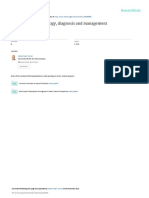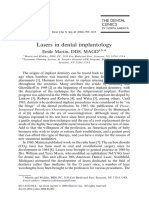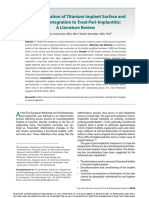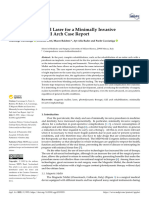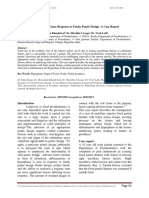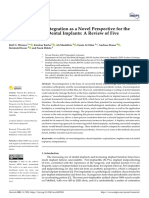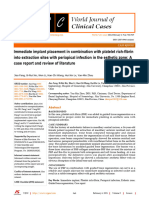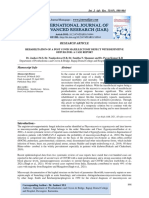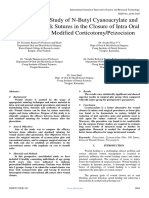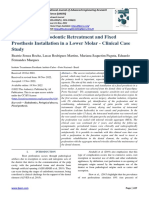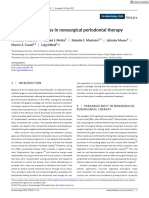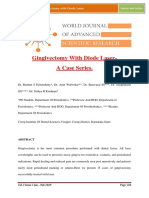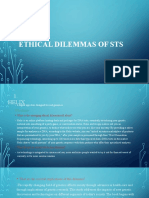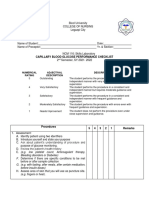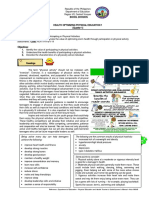Professional Documents
Culture Documents
Clinical Efficacy of Laser Therapy in Peri-Implant It Is A Review
Original Title
Copyright
Available Formats
Share this document
Did you find this document useful?
Is this content inappropriate?
Report this DocumentCopyright:
Available Formats
Clinical Efficacy of Laser Therapy in Peri-Implant It Is A Review
Copyright:
Available Formats
Volume 7, Issue 10, October – 2022 International Journal of Innovative Science and Research Technology
ISSN No:-2456-2165
Clinical Efficacy of Laser Therapy in
Peri-Implant it is: A Review
Dr. Renuka Saini
BDS, SGT University, Gurugram
Abstract:- Dental Implantology has evolved into a Risk factors that increase a person's probability of
therapeutic option with an incredibly predictable developing peri implantitis, which shares many symptoms
outcome. It is used extensively in regular clinical practice with periodontitis, include prior periodontal disease, poor
and provides an effective treatment alternative for dental hygiene, smoking, hereditary factors, diabetes,
treating a wide range of patients. Pathological diseases in leftover cement, and occlusal overload.4The primary cause
the tissues around dental implants, such as "mucositis" of peri-implantitis is assumed to be microorganisms
and "peri-implantitis," can cause osseointegration residing on the implant surface. These bacteria establish a
problems over time. Despite the fact that a variety of biofilm that prevents bone cells from reattaching to the
treatments have been recommended for peri-implant implant surface and triggers a detrimental inflammatory
care, lasers have cemented themselves as the gold cascade in the host.5
standard for treating peri-implantitis and lowering
bacterial counts in the afflicted regions. Clinical evidence for PI includes bleeding post probing
in the peri implant area, an increase in probing depth, and
Keywords:- Lasers, peri implantitis, osseointegration, Er: marginal bone loss.6According to a review paper written by
YAG, Diode. Mombelli and his colleague, the prevalence of PI was
estimated at 10% of implants and 20% of patients five to ten
I. INTRODUCTION years following implant loading.7
Dental implantology has become a treatment option III. TREATMENT APPROACHES
harnessing a remarkably predictable outcome. It forms up a
large part of the daily clinical practice and offers a Even though a number of therapies have been
successful therapeutic option available for treating patients indicated for peri-implant care, the literature has not yet
who are partly or completely edentulous. 1Despite their documented a consensus on the approach that is the most
technical development taking place at the beginning of dependable, repeatable, and efficient. In order to
1960, when Branemarck's group introduced fresh and successfully treat PI, it is vital to decontaminate the
ground-breaking ideas based on their recognition of the implant components in addition to removing any inflamed
biological phenomena that took place at the interface soft tissue from the peri-implant region.8Various surgical
between bone and implant, implant-supported prosthetics in and non-surgical therapies are aimed in eliminating bacterial
dentistry only eventually started to be implemented. biofilms formed on dental implants for example mechanical
Osseointegration is the term used to refer to the debridement, disinfection with chemotherapeutic agents,
development of a rigid and functional bond between bone smoothing implant surface and laser therapy, which is the
and an implant fixture when both are being loaded by a new treatment modality employed.9
prosthetic device without the intervention of connective
tissue. Even yet, osseointegration errors may result from With carbon, plastic, titanium, ultrasonic scaling, or
pathological conditions to the tissues around dental implants powder air abrasion, mechanical debridement can be
over time. These pathological conditions, which are referred accomplished.10Tetracycline fibres, chlorhexidine
to as "mucositis" and "peri-implantitis" (PI) depending on digluconate, and minocycline microspheres all appear to
whether the inflammatory processes only affect the marginal possess powerful antibacterial properties. Due to resistant
gingiva or the deep peri-implant tissues, have risen in recent bacterial strains, restricted access to the inflamed region,
years in direct proportion to the use of dental implants. 2 and pharmacologic constraints like inadequate antibacterial
action or insufficient medication dose, the efficacy of
II. PERI- IMPLATITIS AND IMPLANT FAILURE mechanical or chemical modalities appears to be
constrained.11Additionally, mechanical techniques including
A complicated concept known as peri-implantitis (PI) metallic curettes, ultrasonic metal tip scalers, and air powder
affects the tissues surrounding an implant that is continually abrasion may cause an implant's surface to become rougher,
performing its intended function. An inflammatory cascade which in turn promotes bacterial colonisation and biofilm
that would initially affect the superficial peri-implant soft development.12
tissues (mucositis) and then progress into the deep layers,
with a loss of implant support bone that can be clinically and Recently, a discernible trend has compelled scientists
radiologically highlighted, could be brought on by a to use lasers to clean inflammatory periimplant tissue. Small
disadvantageous balance between pathogenic bacterial load portions of the implant surface that mechanical techniques
and host response (peri-implantitis).3 are unable to reach can be effectively irradiated by lasers.
The selective calculus removal, antibacterial, and hemostatic
actions of lasers all contribute to improved clinical
IJISRT22OCT516 www.ijisrt.com 301
Volume 7, Issue 10, October – 2022 International Journal of Innovative Science and Research Technology
ISSN No:-2456-2165
results.13The effectiveness of Er:YAG (Erbium-Doped methodology (RCT) of test and control, Schwarz et al.
Yttrium Aluminum Garnet), CO2 (Carbon Dioxide Laser), conducted another study in 2006. The patients were
and Diode lasers in the high or even total removal of followed for up to 12 months. When compared to plastic
bacteria-loaded titanium discs has been demonstrated in in tools and chlorhexidine, Er:YAG significantly reduced BoP
vitro models.14Additionally, microscopic analyses have at 6 months, but at 12 months after treatment, there was no
confirmed that the titanium surface is not disturbed when discernible change in healing.28
these lasers are applied correctly.15,16
Using a test group (Er:YAG) and a control group as
Practitioners must make a number of choices when their comparison, Renvert et al. published a 6-month follow-
thinking about using lasers to treat peri implantitis. There up research (subgingival airborne glycine powder
are several different types of lasers, such as Er:YAG, CO2, polishing). Both at the beginning and six months, they
Diode, Er,Cr:YSGG (Erbium, Chromium doped Yttrium measured the BoP and pocket depth. Both treatment
Scandium Gallium Garnet), and diode lasers (810 nm, 940 modalities resulted in comparable recovery surrounding the
nm, and 980 nm) (NeodymiumDoped Yttrium Aluminium implants, they discovered.29Following the usage of the
Garnet). It could be necessary to combine laser therapy with Er:YAG laser for six months, Badran et al. reported on a
additional forms of treatment.17Thus the aim of this current single implant that had been identified with peri-implantitis.
review is to highlight the use of lasers in the treatment of After undergoing nonsurgical treatment, the patient had
peri implantitis and to review the efficacy of different lasers surgery. The findings revealed no BoP and a decrease in
in the treatment of the same. probing depth (2 to 5 mm), but an increase in gingival
recession (1 to 2 mm). The process of bone healing
IV. ER:YAG LASER FOR TREATMENT OF HUMAN surrounding the implant was effective.30Using the Er:YAG
PERIIMPLANTITIS laser alone to treat peri-implantitis without surgical
intervention was shown to be ineffective in one of the
Under the proper irradiation parameters, it has been studies included in a comprehensive review by Schwarz et
demonstrated that utilising the Er:YAG laser, contaminated al.31
abutments may be successfully cleaned of calculus and
plaque. This is accomplished while causing any surface V. ND:YAG LASER FOR TREATMENT OF HUMAN
damage to the titanium and without greatly raising the PERIIMPLANTITIS
temperature. It has been proven that using the Er:YAG laser,
contaminated abutments may be effectively cleared of Initially, the neodymium-doped yttrium-aluminum-
calculus and plaque under the right irradiation conditions garnet (Nd:YAG) laser (Nd:Y3Al5O12) was advised against
without titanium surface deterioration or considerable using it near implants because it caused morphologic
temperature rise.18 changes to the titanium surface, such as melting, cracking,
and cratering. Microorganism growth in those voids or
In light of the findings of earlier research and the porosities may be facilitated by changes in the surface
benefits of the Er:YAG laser in periodontal treatment, such topography.32,33
as its superior tissue ablation,19with high bactericidal,20 and
detoxification effects,21 the potential of Er:YAG laser On the other hand, Giannini et al. observed that the
application for the treatment of peri-implantitis would be Nd:YAG laser, when applied in vitro at low pulse energy,
expected.22When paired with local antibiotics, Er:YAG may had a bactericidal effect without causing any harm to the
lessen the clinical indications of inflammation when treating titanium surface.34No human studies have yet evaluated the
peri-implantitis without surgery, according to studies that effect of Nd:YAG laser therapy on peri-implantitis.
compared it to curettes and chlohexidine.23A systematic
review of laser treatment conducted by Kotsovilis et al., who VI. CO2LASER FOR TREATMENT OF HUMAN
came to the conclusion that Er:YAG combined with PERIIMPLANTITIS
mechanical debridement may be utilised for peri-
implantitis.24Three different laser types were reviewed by A gas-active medium laser, the CO2 laser uses an
Kotsakis et al., some of which were applied as a peri- electrical discharge current to pump a gaseous mixture
implantitis treatment adjunct, but no conclusion was drawn including CO2 molecules inside a sealed tube. The
as to which laser type was better than the others. 25Mailoa et versatility and accuracy needed for soft tissue surgical
al. reported on the use of two types of lasers (Er:YAG and operations are provided by the CO2 laser's capacity to
CO2) to treat peri-implantitis in both people and animals, deliver the requisite power in continuous and gated modes
but other laser types were left out of the review. 26 with focused or nonfocused hand-pieces. This wavelength,
which is nearly 1000 times more effective than erbium, has
The impact of the Er:YAG laser on peri-implantitis has the greatest hydroxyapatite absorption of any dental laser.
been shown in papers by Schwarz et al. Following therapy, To protect tooth structure from the incident laser beam at the
the patients came back six months later. Both the use of soft tissue surgery site, it is necessary. 35
Er:YAG and plastic tools resulted in appreciable
advancements in the healing process surrounding the Patients in a study by Deppe et al. were followed for 5
implant; however, the use of Er:YAG led to a higher years. Results obtained four months after treatment
decrease in BoP than the use of plastic instruments indicated that using a CO2 laser in conjunction with
alone.27In a different population and using the same research removing soft tissue may have sped up the healing process.
The CO2 laser and airborne-powder abrasion (Prophy-Jet,
IJISRT22OCT516 www.ijisrt.com 302
Volume 7, Issue 10, October – 2022 International Journal of Innovative Science and Research Technology
ISSN No:-2456-2165
Dentsply) did not vary in the long-term results for implant The diode laser also stimulates fibroblasts and
decontamination treatment.36The CO2 laser, in combination osteoblasts, which leads to an increase in RNA messenger
with augmentative approaches, may be a successful synthesis and considerable collagen creation during
treatment option for peri-implantitis, according to the periodontal tissue repair, potentially making it a viable
findings of a case series research by Romanos et al. that alternative strategy for the treatment of peri-implantitis.48
lasted 27 months.37
In one in vitro study, Stübinger et al. discovered that
Based on preliminary clinical results, Romanos et al. the removal of bacteria that cause peri-implantitis, such as
investigations from 2008 and 2009 concluded that CO2 laser Streptococcus sanguinis and Porphyromansgingivalis, was
was a useful technique for implant surface cleansing. In effective regardless of the implant material when using a
Romanos et al 2008's trial, BOP and PPD were greatly diode laser with an 810-nm wavelength, 3 W for 10 s, and a
decreased, and an adequate rate of bone fill was attained; 200-m fibre tip.47
nevertheless, the breadth of keratinized mucosa didn't
increase appreciably. It was unclear whether there had been Diode laser was employed by Schar et al. and Bassetti
any change in the pattern of healing because they had only et al. using the exact same protocols, including laser
compared the indices at baseline and final with a follow-up irradiation in conjunction with Phenothiazine chloride, 3
period of 27±17 months. Romano's 2009 study did not minutes after hand curettage, air powder abrasion, and
contain any soft tissue measurements, and evaluation was irrigation with hydrogen peroxide. One week after the initial
entirely based on radiographic signs of healing. 38,39 treatment, adjunctive PDT (Photodynamic Therapy) was
performed. In both investigations, the modified plaque index
VII. Er,Cr:YSGGLASER FOR TREATMENT OF was recorded, and at the final treatment checkups, it was
HUMAN PERIIMPLANTITIS significantly lower (6 and 12 months respectively). The laser
group had no plaque at month 6 according to Schar et al. 49,50
With a wavelength of 2.78 m, Er,Cr:YSGG lasers
belong to the family of erbium lasers and exhibit very IX. DISCUSSION
shallow tissue penetration, offering little thermal danger to
deeper tissues. Er,Cr:high YSGG's absorption in water has The major objectives of treating peri-implantitis are to
been linked to the morphological surface modifications it eradicate the inflammatory lesion, stop the disease's
promotes. In comparison to standard treatment protocol, the development, and preserve function with healthy peri-
use of the Er,Cr:YSGG laser as an adjuvant has reportedly implant tissues. The elimination of etiologic elements such
been found to be more successful in reducing bacterial adherent plaque, bacterial deposits, and diseased connective
growth.40 tissue inside intrabony defects around the implants have all
been recognised as crucial to achieving the desired outcome.
A low-energy Er:YAG laser appears to have However, due to their propensity for damaging the titanium
favourable effects when used to clean the implant surfaces of implants, conventional mechanical instruments
surfaces.41A single implant was monitored for 18 months’ like steel curets or ultrasonic scalers are not entirely suitable
time period in a study published by Azzeh in 2008. Using for the removal of granulation tissue and implant surface
Er,Cr:YSGG, the implant surface was decontaminated at the debridement. This could obstruct the process of bone
time of surgery followed by anorganic bovine bone grafting healing.As a result, mechanical tools like plastic curets and
in the defect location, and a resorbable membrane was carbon fibre curettes are typically used for implant
placed over the top. All probing depths were 2 mm 18 debridement.51
months after surgery, and the implant's surrounding osseous
tissue was found to be regenerating.42 The thorough debridement of the bone defect and the
contaminated implant surface, however, appears to be
VIII. DIODE LASER FOR TREATMENT OF inefficient using these procedures, and mechanical
HUMAN PERI IMPLANTITIS debridement is difficult and time-consuming.Because of
this, mechanical debridement in the case of peri-implantitis
Diode lasers are produced at a variety of wavelengths, has made it much harder to completely remove pollutants
including 810 nm, 940 nm, and 980 nm. They can be used in like bacteria and their byproducts and soft tissue cells from
gated pulse mode or continuous wave mode, which emits the rough surface, and the residual plaque biofilm may
energy as a steady beam (energy emitted as a constant but hinder the healing of the peri-implant tissues.52Novel
interrupted beam).43Gallium-aluminum-arsenide (810 nm) treatment techniques utilising lasers have received a lot of
and indium-gallium-arsenide (InGaAs) lasers are the two interest recently. Lasers have been used in periimplant
most often employed wavelengths in the treatment of peri- therapy as an additional or alternative treatment and are
implantitis (980 nm).44Since the peak water absorption will anticipated to alleviate the issues and challenges of the
help prevent a temperature increase at the implant surface, traditional mechanical treatment. According to the results of
the use of a 980-nm diode laser has been demonstrated to be the current review, only CO2, DIODE, and Er:YAG lasers
more favourable around dental implants, even at higher were utilised to effectively treat peri-implantitis lesions.
power levels.45The bactericidal impact of this wavelength on This could be explained by the fact that these two kinds of
implant surfaces has also been demonstrated in tests without lasers did not considerably raise the body temperature of the
altering the pattern of the implant surface. 46,47 implants while they were being used. 53
IJISRT22OCT516 www.ijisrt.com 303
Volume 7, Issue 10, October – 2022 International Journal of Innovative Science and Research Technology
ISSN No:-2456-2165
An fascinating laser that has not been discussed in any [7.] Mombelli A, Müller N, Cionca N. The epidemiology
research is the neodymium: yttrium-aluminum-garnet of peri-implantitis. Clin Oral Implants Res.
(Nd:YAG) laser; one justification for this is that titanium is 2012;23:67-76.
abraded by Nd:YAG lasers independent of output energy. [8.] Esposito M, Grusovin MG, Kakisis I, Coulthard P,
The use of Nd:YAG for the treatment of periimplantitis Worthington HV. Interventions for replacing missing
might not be advised due to the high temperature and teeth: treatment of perimplantitis. Cochrane Database
titanium's propensity to melt.33Additionally, CO2 and Syst Rev. 2008;16:CD004970.
Er:YAG lasers were the only ones to be described as having [9.] Ntrouka VI, Slot DE, Louropoulou A, Van der
a variety of bactericidal effects on textured implant Weijden F. The effect of chemotherapeutic agents on
surfaces.54All periimplantitis patients in human clinical contaminated titanium surfaces: a systematic review.
studies who had surgical or non-surgical laser treatment for Clin Oral Implants Res. 2011;22:681-90.
their condition exhibited a decrease in PD and BOP. The [10.] Persson GR, Salvi GE, Heitz-Mayfield LJ, Lang NP.
laser group's lower PD and BOP scores might be attributed Antimicrobial therapy using a local drug delivery
to their strong bactericidal effects.55,56 system (Arestin) in the treatment of peri-implantitis.
I: Microbiological outcomes. Clin Oral Implants Res.
The elimination of lipopolysaccharides by laser 2006;17:386-93.
radiation and the antibacterial activities against [11.] Peters N, Tawse-Smith A, Leichter J, Tompkins G.
periodontopathic bacteria were also documented in various Laser therapy: the future of peri-implantitis
research.57 According to a prior study, employing CO2 management. Braz J Periodontol. 2012;22:23-9.
lasers along with bone grafting material resulted in a 40% [12.] Gosau M, Hahnel S, Schwarz F, Gerlach T, Reichert
increase in radiographic bone fill when compared to the TE, Bürgers R. Effect of six different peri-implantitis
control group.58 disinfection methods on in vivo human oral biofilm.
Clin Oral Implants Res. 2010;21:866-72.
X. CONCLUSION [13.] Matsuyama T, Aoki A, Oda S, Yoneyama T,
Nowadays, laser therapies offer a novel treatment Ishikawa I. Effects of the Er:YAG laser irradiation on
approach for peri implantitits and they are being integrated titanium implant materials and contaminated implant
along with conventional mechanical therapies.Er:YAG , abutment surfaces. J Clin Laser Med Surg.
Diode and CO2 Lasers have demonstrated better results as 2003;21:7-17.
compared to Nd:YAG Laser. A significant reduction in PPD [14.] Tosun E, Tasar F, Strauss R, Kıvanc DG, Ungor C.
and BOP was seen along with high bactericidal effects on Comparative evaluation of antimicrobial effects of
the implant surface. The results validate the efficacy of the Er:YAG, diode, and CO₂ lasers on titanium discs: an
laser irradiation in high decontamination of anaerobic experimental study. J Oral Maxillofac Surg.
bacteria and improving bone regeneration, therefore making 2012;70:1064-9.
the use of lasersan essential part of the treatment protocol [15.] Stubinger S, Etter C, Miskiewicz M, Homann F,
for peri- implantitis. Saldamli B, Wieland M, Sader R. Surface alterations
of polished and sandblasted and acid-etched titanium
REFERENCES implants after Er:YAG, carbon dioxide, and diode
laser irradiation. Int J Oral Maxillofac Implants. 2010
[1.] Sánchez-Gárces MA, Gay-Escoda C. Periimplantitis. ;25:104-11.
Med Oral Patol Oral Cir Bucal. 2004; 63:69-74. [16.] Park JH, Heo SJ, Koak JY, Kim SK, Han CH, Lee
[2.] López-Cerero L. Infeccionesrelacionadas con JH. Effects of laser irradiation on machined and
losimplantesdentarios [Dental implant-related anodized titanium disks. Int J Oral Maxillofac
infections]. EnfermInfeccMicrobiol Clin. Implants. 2012;27:265-72.
2008;26:589-92. [17.] Ashnagar S, Nowzari H, Nokhbatolfoghahaei H,
[3.] Algraffee H, Borumandi F, Cascarini L. Peri- Yaghoub Zadeh B, Chiniforush N, Choukhachi Zadeh
implantitis. Br J Oral Maxillofac Surg. 2012;50:689- N. Laser treatment of peri-implantitis: a literature
94. review. J Lasers Med Sci. 2014;5:153-62.
[4.] Lindhe J, Meyle J. Peri-implant diseases: Consensus [18.] Takasaki AA, Aoki A, Mizutani K, Kikuchi S, Oda S,
Report of the Sixth European Workshop on Ishikawa I. Er:YAG laser therapy for peri-implant
Periodontology. J Clin Periodontol. 2008;35:282-5. infection: a histological study. Lasers Med Sci.
[5.] Salmeron S, Rezende ML, Consolaro A, Sant’Ana 2007;22:143-57.
AC, Damante CA, Greghi SL, et al. Laser therapy as [19.] Mizutani K, Aoki A, Takasaki AA, Kinoshita A,
an effective method for implant surface Hayashi C, Oda S, Ishikawa I. Periodontal tissue
decontamination: A histomorphometric study in rats. healing following flap surgery using an Er:YAG laser
J Periodontol. 2013;84:641-9. in dogs. Lasers Surg Med. 2006;38:314-24.
[6.] Renvert S, Hirooka H, Polyzois I, Kelekis-Cholakis [20.] Ando Y, Aoki A, Watanabe H, Ishikawa I.
A, Wang HL. Working Group 3. Diagnosis and non- Bactericidal effect of erbium YAG laser on
surgical treatment of peri-implant diseases and periodontopathic bacteria. Lasers Surg Med.
maintenance care of patients with dental implants - 1996;19:190-200.
Consensus report of working group 3. Int Dent J. [21.] Yamaguchi H, Kobayashi K, Osada R, Sakuraba E,
2019;69:12-17. Nomura T, Arai T, Nakamura J. Effects of irradiation
IJISRT22OCT516 www.ijisrt.com 304
Volume 7, Issue 10, October – 2022 International Journal of Innovative Science and Research Technology
ISSN No:-2456-2165
of an erbium:YAG laser on root surfaces. J with the concomitant use of purephase beta-
Periodontol. 1997;68:1151-5. tricalcium phosphate: A 5-year clinical report. Int J
[22.] Aoki A, Sasaki KM, Watanabe H, Ishikawa I. Lasers Oral Maxillofac Implants 2007;22:79–86.
in nonsurgical periodontal therapy. Periodontol 2000. [37.] Romanos GE, Nentwig GH. Regenerative therapy of
2004;36:59-97. deep peri-implant infrabony defects after CO2 laser
[23.] Muthukuru M, Zainvi A, Esplugues EO, Flemmig implant surface decontamination. Int J Periodontics
TF. Non-surgical therapy for the management of peri- Restorative Dent 2008;28:245–55.
implantitis: a systematic review. Clin Oral Implants [38.] Hürzeler MB, Quinones CR, Schüpbach P, Morrison
Res. 2012;23:77-83. EC, Caffesse RG. Treatment of periimplantitis using
[24.] Kotsovilis S, Karoussis IK, Trianti M, Fourmousis I. guided bone regeneration and bone grafts, alone or in
Therapy of peri-implantitis: a systematic review. J combination, in beagle dogs. Part 2: Histologic
Clin Periodontol. 2008;35:621-9. findings. Int J Oral Maxillofac 1997;12: 168–175.
[25.] Kotsakis GA, Konstantinidis I, Karoussis IK, Ma X, [39.] Romanos G, Ko H-H, Froum S, Tarnow D. The use
Chu H. Systematic review and meta-analysis of the of CO2 laser in the treatment of peri-implantitis.
effect of various laser wavelengths in the treatment of Photomedicine and laser surgery. 2009;27:381-6.
peri-implantitis. J Periodontol. 2014;85:1203-13. [40.] Dereci Ö, Hatipoğlu M, Sindel A, Tozoğlu S, Üstün
[26.] Mailoa J, Lin GH, Chan HL, MacEachern M, Wang K. The efficacy of Er,Cr:YSGG laser supported
HL. Clinical outcomes of using lasers for peri- periodontal therapy on the reduction of peridodontal
implantitis surface detoxification: a systematic review disease related oral malodor: a randomized clinical
and meta-analysis. J Periodontol. 2014;85:1194-202. study. Head Face Med. 2016;12:20.
[27.] Renvert S, Lindahl C, RoosJansåker AM, Persson [41.] Chegeni E, España-Tost A, Figueiredo R,
GR. Treatment of peri-implantitis using an Er:YAG Valmaseda-Castellón E, Arnabat-Domínguez J.
laser or an air-abrasive device: a randomized clinical Effect of an Er,Cr:YSGG Laser on the Surface of
trial. J Clin Periodontol. 2011;38:65-73. Implants: A Descriptive Comparative Study of 3
[28.] Schwarz F, Bieling K, Bonsmann M, Latz T, Becker Different Tips and Pulse Energies. Dent J (Basel).
J. Nonsurgical treatment of moderate and advanced 2020;8:109.
periimplantitis lesions: a controlled clinical study. [42.] Azzeh MM. Er,Cr:YSGG laser-assisted surgical
Clin Oral Investig. 2006;10:279-88. treatment of peri-implantitis with 1-year reentry and
[29.] Schwarz F, Sculean A, Rothamel D, Schwenzer K, 18-month follow-up. J Periodontol2008;79:2000–5.
Georg T, Becker J. Clinical evaluation of an Er:YAG [43.] Stubinger S, Etter C, Miskiewicz M, Homann F,
laser for nonsurgical treatment of peri-implantitis: a Saldamli B, Wieland M, Sader R. Surface alterations
pilot study. Clin Oral Implants Res. 2005;16:44-52. of polished and sandblasted and acid-etched titanium
[30.] Badran Z, Bories C, Struillou X, Saffarzadeh A, implants after Er:YAG, carbon dioxide, and diode
Verner C, Soueidan A. Er:YAG laser in the clinical laser irradiation. Int J Oral Maxillofac Implants.
management of severe peri-implantitis: a case report. 2010;25:104-11.
J Oral Implantol. 2011;37:212-7. [44.] Schwarz F, Aoki A, Sculean A, Becker J. The impact
[31.] Schwarz F, Bieling K, Nuesry E, Sculean A, Becker of laser application on periodontal and peri-implant
J. Clinical and histological healing pattern of peri- wound healing. Periodontol 2000. 2009;51:79-108.
implantitis lesions following non-surgical treatment [45.] Azma E, Safavi N. Diode laser application in soft
with an Er:YAG laser. Lasers Surg Med. tissue oral surgery. J Lasers Med Sci. 2013;4:206-11.
2006;38:663-71. [46.] Natto ZS, Aladmawy M, Levi PA Jr, Wang HL.
[32.] Kreisler M, Kohnen W, Christoffers AB, Götz H, Comparison of the efficacy of different types of lasers
Jansen B, Duschner H, d'Hoedt B. In vitro evaluation for the treatment of peri-implantitis: a systematic
of the biocompatibility of contaminated implant review. Int J Oral Maxillofac Implants. 2015;30:338-
surfaces treated with an Er : YAG laser and an air 45.
powder system. Clin Oral Implants Res. 2005;16:36- [47.] Hauser-Gerspach I, Stübinger S, Meyer J.
43. Bactericidal effects of different laser systems on
[33.] Romanos GE, Everts H, Nentwig GH. Effects of bacteria adhered to dental implant surfaces: an in
diode and Nd:YAG laser irradiation on titanium vitro study comparing zirconia with titanium. Clin
discs: a scanning electron microscope examination. J Oral Implants Res. 2010;21:277-83.
Periodontol. 2000;71:810-5. [48.] Roncati M, Lucchese A, Carinci F. Non-surgical
[34.] Giannini R, Vassalli M, Chellini F, Polidori L, Dei R, treatment of peri-implantitis with the adjunctive use
Giannelli M. Neodymium:yttrium aluminum garnet of an 810-nm diode laser. J Indian Soc Periodontol.
laser irradiation with low pulse energy: a potential 2013 Nov;17:812-5.
tool for the treatment of peri-implant disease. Clin [49.] Schär D, Ramseier CA, Eick S, Arweiler NB, Sculean
Oral Implants Res. 2006;17:638-43. A, Salvi GE. Anti-infective therapy of peri-
[35.] Garg N, Verma S, Chadha M, Rastogi P. Use of implantitis with adjunctive local drug delivery or
carbon dioxide laser in oral soft tissue photodynamic therapy: six-month outcomes of a
procedures. Natl J Maxillofac Surg. 2015;6:84-88. prospective randomized clinical trial. Clinical oral
[36.] Deppe H, Horch HH, Neff A. Conventional versus implants research. 2013;24:104-10.
CO2 laser-assisted treatment of peri-implant defects
IJISRT22OCT516 www.ijisrt.com 305
Volume 7, Issue 10, October – 2022 International Journal of Innovative Science and Research Technology
ISSN No:-2456-2165
[50.] Bassetti M, Schär D, Wicki B, Eick S, Ramseier CA,
Arweiler NB, Sculean A, Salvi GE. Anti-infective
therapy of peri-implantitis with adjunctive local drug
delivery or photodynamic therapy: 12-month
outcomes of a randomized controlled clinical trial.
Clin Oral Implants Res. 2014;25:279-287.
[51.] Schwarz F, Sculean A, Rothamel D, Schwenzer K,
Georg T, Becker J. Clinical evaluation of an Er:YAG
laser for nonsurgical treatment of peri-implantitis: a
pilot study. Clin Oral Implants Res. 2005;16:44-52.
[52.] Schwarz F, Sculean A, Romanos G, Herten M, Horn
N, Scherbaum W, Becker J. Influence of different
treatment approaches on the removal of early plaque
biofilms and the viability of SAOS2 osteoblasts
grown on titanium implants. Clin Oral Investig.
2005;9:111-7.
[53.] Kreisler M, Kohnen W, Marinello C, et al.
Bactericidal effect of the Er:YAG laser on dental
implant surfaces: An in vitro study. J Periodontol
2002;73: 1292-98.
[54.] Kato T, Kusakari H, Hoshino E. Bactericidal efficacy
of carbon dioxide laser against bacteria-contaminated
titanium implant and subsequent cellular adhesion to
irradiated area. Lasers Surg Med 1998;23:299-309.
[55.] Kreisler M, Kohnen W, Marinello C, et al.
Bactericidal effect of the Er:YAG laser on dental
implant surfaces: An in vitro study. J Periodontol
2002;73: 1292-98.
[56.] Yamaguchi H, Kobayashi K, Osada R, et al. Effects
of irradiation of an erbium:YAG laser on root
surfaces. J Periodontol1997;68:1151-55.
[57.] Deppe H, Horch HH, Neff A. Conventional versus
CO2 laser-assisted treatment of peri-implant defects
with the concomitant use of pure-phase beta-
tricalcium phosphate: A 5-year clinical report. Int J
Oral Maxillofac Implants 2007;22:79-86.
[58.] Stubinger S, Henke J, Donath K, Deppe H. Bone
regeneration after peri-implant care with the CO2
laser: A fluorescence microscopy study. Int J Oral
Maxillofac Implants 2005;20:203-10.
IJISRT22OCT516 www.ijisrt.com 306
You might also like
- Zygomatic Implants: Optimization and InnovationFrom EverandZygomatic Implants: Optimization and InnovationJames ChowNo ratings yet
- 1-s2.0-S0020653922001708-mainDocument11 pages1-s2.0-S0020653922001708-mainHONG JIN TANNo ratings yet
- Nanotechnology in Temporary Anchorage Devices: Dr. Chelza X, Dr. Anand SivadasaDocument3 pagesNanotechnology in Temporary Anchorage Devices: Dr. Chelza X, Dr. Anand SivadasajayashreeNo ratings yet
- 1 s2.0 S0020653920322735 MainDocument5 pages1 s2.0 S0020653920322735 MainPABLO ANDRÉS SAAVEDRA ORDENESNo ratings yet
- Untitled 3Document10 pagesUntitled 3Satya AsatyaNo ratings yet
- Peri Implantitisetiologydiagnosisandmanagement PDFDocument49 pagesPeri Implantitisetiologydiagnosisandmanagement PDFRobins DhakalNo ratings yet
- Lasers in Dental ImplantologyDocument17 pagesLasers in Dental ImplantologyIulian CosteanuNo ratings yet
- All Studies On Antiboitic Coated NailsDocument7 pagesAll Studies On Antiboitic Coated NailsMutturaj SaroorNo ratings yet
- Decontamination of Titanium Implant Surface and Re-Osseointegration To Treat Peri-Implantitis: A Literature ReviewDocument12 pagesDecontamination of Titanium Implant Surface and Re-Osseointegration To Treat Peri-Implantitis: A Literature ReviewAlejandra Del PilarNo ratings yet
- 7 TH JC PDF - SindhuDocument5 pages7 TH JC PDF - SindhuDadi SindhuNo ratings yet
- Effect of Low Level Laser Therapy On Wound Healing AfterDocument6 pagesEffect of Low Level Laser Therapy On Wound Healing AfterYou're Just As Sane As DivaNo ratings yet
- Applsci 12 09995 v2Document13 pagesApplsci 12 09995 v2ns.drgreenNo ratings yet
- Bioceramic For The Repair of Internal ResorptionDocument6 pagesBioceramic For The Repair of Internal ResorptionDana StanciuNo ratings yet
- Lasers in PeriodonticsDocument61 pagesLasers in PeriodonticsDrRanjeet Kumar ChaudharyNo ratings yet
- Japid 14 26Document6 pagesJapid 14 26rikaNo ratings yet
- Laser Periodontal TreatmentDocument3 pagesLaser Periodontal TreatmentmanikantatssNo ratings yet
- Lasers in Dental ImplantologyDocument18 pagesLasers in Dental ImplantologyErty TyuuNo ratings yet
- Efficacy of Nano-Hydroxyapatite Coating On Osseointegration of Early Loaded Dental ImplantsDocument12 pagesEfficacy of Nano-Hydroxyapatite Coating On Osseointegration of Early Loaded Dental ImplantsIJAR JOURNALNo ratings yet
- Depigmentation Using Scalpel and Diode Laser A Split Mouth Case ReportDocument5 pagesDepigmentation Using Scalpel and Diode Laser A Split Mouth Case ReportInternational Journal of Innovative Science and Research TechnologyNo ratings yet
- Regeneration of Periapical Bone in Surgical Endodontics: A Case ReportDocument7 pagesRegeneration of Periapical Bone in Surgical Endodontics: A Case ReportInternational Journal of Innovative Science and Research TechnologyNo ratings yet
- Correcting Labial Frenum Using LaserDocument3 pagesCorrecting Labial Frenum Using LaserNisatriaNo ratings yet
- Fibrous Hyperplasia - A Case ReportDocument4 pagesFibrous Hyperplasia - A Case ReportInternational Journal of Innovative Science and Research TechnologyNo ratings yet
- Bactericidal Effect of Er:YAG Laser on Dental ImplantsDocument7 pagesBactericidal Effect of Er:YAG Laser on Dental ImplantsPeter von TanNo ratings yet
- Photo-Biomodulation in EndodonticsDocument7 pagesPhoto-Biomodulation in EndodonticsInternational Journal of Innovative Science and Research TechnologyNo ratings yet
- Endodontic Surgery in A Lower Molar Affected by Root Resorption and Fractured InstrumentDocument5 pagesEndodontic Surgery in A Lower Molar Affected by Root Resorption and Fractured InstrumentIJAERS JOURNALNo ratings yet
- Peri-Implantitis: A Curse To ImplantsDocument11 pagesPeri-Implantitis: A Curse To ImplantsIJRASETPublicationsNo ratings yet
- Bone and Soft Tissue Outcomes, Risk Factors, and Complications of Implant Supported Prostheses 5 Years RCT With Different Abutment Types and LoadiDocument9 pagesBone and Soft Tissue Outcomes, Risk Factors, and Complications of Implant Supported Prostheses 5 Years RCT With Different Abutment Types and LoadiBagis Emre GulNo ratings yet
- Case Report Management of Adverse Tissue Response To Faulty Pontic Design-A Case ReportDocument5 pagesCase Report Management of Adverse Tissue Response To Faulty Pontic Design-A Case ReportNajeeb UllahNo ratings yet
- Laser treatment reduces periodontal pathogens more than SRPDocument10 pagesLaser treatment reduces periodontal pathogens more than SRPeliasNo ratings yet
- Case Report19Document6 pagesCase Report19irfanaNo ratings yet
- Photobiomodulation Therapy Assisted Orthodontic Tooth MovementDocument17 pagesPhotobiomodulation Therapy Assisted Orthodontic Tooth MovementKarina CarlinNo ratings yet
- Materials 14 07829 PDFDocument19 pagesMaterials 14 07829 PDFQS ZHOUNo ratings yet
- Berglundh Et Al-2018-Journal of Clinical PeriodontologyDocument6 pagesBerglundh Et Al-2018-Journal of Clinical PeriodontologyCristian CulcitchiNo ratings yet
- Comparison of Anchorage Efficiency of Orthodontic Mini-Implant and Conventional Anchorage Reinforcement in Patients Requiring Maximum Orthodontic Anchorage - A Systematic Review and Meta-AnalysisDocument13 pagesComparison of Anchorage Efficiency of Orthodontic Mini-Implant and Conventional Anchorage Reinforcement in Patients Requiring Maximum Orthodontic Anchorage - A Systematic Review and Meta-AnalysisMariaNo ratings yet
- Surgical Treatment in A Dental Element Affected by Overfilling: Case ReportDocument5 pagesSurgical Treatment in A Dental Element Affected by Overfilling: Case ReportIJAERS JOURNALNo ratings yet
- Peri-Implantitis Summary and Consensus Statements of Group 3. The 6th EAO Consensus Conference 2021Document9 pagesPeri-Implantitis Summary and Consensus Statements of Group 3. The 6th EAO Consensus Conference 2021kaue francoNo ratings yet
- The Use of Er:YAG, Nd:YAG and Ga-Al-As Lasers in Periapical Surgery: A 3-Year Clinical StudyDocument6 pagesThe Use of Er:YAG, Nd:YAG and Ga-Al-As Lasers in Periapical Surgery: A 3-Year Clinical StudyTôn Thất Đam TriềuNo ratings yet
- FANGDocument8 pagesFANGDDNo ratings yet
- Implant Surface Decontamination by Surgical Reatment of Periimplantitis A Literature ReviewDocument4 pagesImplant Surface Decontamination by Surgical Reatment of Periimplantitis A Literature Reviewkaue francoNo ratings yet
- Rehabilitation of A Post Covid Maxillectomy Defect With Definitive Obturator: A Case ReportDocument7 pagesRehabilitation of A Post Covid Maxillectomy Defect With Definitive Obturator: A Case ReportIJAR JOURNALNo ratings yet
- A Comparative Study of N-Butyl Cyanoacrylate and Conventional Silk Sutures in The Closure of Intra Oral Incisions After Modified CorticotomyPeizocisionDocument10 pagesA Comparative Study of N-Butyl Cyanoacrylate and Conventional Silk Sutures in The Closure of Intra Oral Incisions After Modified CorticotomyPeizocisionInternational Journal of Innovative Science and Research TechnologyNo ratings yet
- 6038ed9dcef5d IJAR-35170Document5 pages6038ed9dcef5d IJAR-35170Ahmed BadrNo ratings yet
- Electrospinning Approaches For Periodontal Regeneration: A ReviewDocument12 pagesElectrospinning Approaches For Periodontal Regeneration: A ReviewNounaNo ratings yet
- Clin Adv Periodontics - 2023 - Mallappa - Novel Biomaterial Advanced Platelet Rich Fibrin Plus Block For Multiple GingivalDocument7 pagesClin Adv Periodontics - 2023 - Mallappa - Novel Biomaterial Advanced Platelet Rich Fibrin Plus Block For Multiple GingivalNikit DixitNo ratings yet
- Drill Sealing, Endodontic Retreatment and Fixed Prosthesis Installation in A Lower Molar - Clinical Case StudyDocument6 pagesDrill Sealing, Endodontic Retreatment and Fixed Prosthesis Installation in A Lower Molar - Clinical Case StudyIJAERS JOURNALNo ratings yet
- Clinical and Radiological Evaluations of Coronectomy For Impacted Mandibular Third MolarsDocument6 pagesClinical and Radiological Evaluations of Coronectomy For Impacted Mandibular Third MolarsInternational Journal of Innovative Science and Research TechnologyNo ratings yet
- 6Document7 pages6ayisNo ratings yet
- Case Report: Overhanging Fillings in Restorative Dental Treatments and EndodonticsDocument5 pagesCase Report: Overhanging Fillings in Restorative Dental Treatments and EndodonticsKarissa NavitaNo ratings yet
- Minimal Invasiveness in Nonsurgical Periodontal TherapyDocument13 pagesMinimal Invasiveness in Nonsurgical Periodontal Therapymahesh kumarNo ratings yet
- Effect of Photobiomodulation With Low-Level Laser Therapy in Prevention Orthodontic Pain: Case ReportsDocument6 pagesEffect of Photobiomodulation With Low-Level Laser Therapy in Prevention Orthodontic Pain: Case ReportsIJAERS JOURNALNo ratings yet
- 10835-Article Text-51780-1-10-20220425Document9 pages10835-Article Text-51780-1-10-20220425Wilma Nurul AzizahNo ratings yet
- Gingivectomy Laser Case SeriesDocument8 pagesGingivectomy Laser Case SeriesMohamad BasofiNo ratings yet
- 10 1111@cid 12748Document8 pages10 1111@cid 12748Behnam TaghaviNo ratings yet
- Peeters, Putzeys, Thorrez - Unknown - 2019 - Current Insights in The Application of Bone Grafts For Local Antibiotic Delivery in Bone ReDocument9 pagesPeeters, Putzeys, Thorrez - Unknown - 2019 - Current Insights in The Application of Bone Grafts For Local Antibiotic Delivery in Bone ReLievenNo ratings yet
- Surgical Management of Giant Radicular Cyst of Maxillary Central and Lateral Incisor Followed by Apicoectomy - A Case ReportDocument10 pagesSurgical Management of Giant Radicular Cyst of Maxillary Central and Lateral Incisor Followed by Apicoectomy - A Case ReportIJAR JOURNALNo ratings yet
- 5 Management of Internal RootDocument5 pages5 Management of Internal RootDana StanciuNo ratings yet
- Application of Bioabsorbable Plates in Orthognathic SurgeryDocument5 pagesApplication of Bioabsorbable Plates in Orthognathic SurgeryJuan Pablo BulaciosNo ratings yet
- Surgical Therapy of Peri-ImplantitisDocument17 pagesSurgical Therapy of Peri-Implantitiskaue francoNo ratings yet
- Effect of Low-Level Laser Therapy On The Time Needed For Leveling andDocument9 pagesEffect of Low-Level Laser Therapy On The Time Needed For Leveling andEsmeralda SoriaNo ratings yet
- Resultados do Tratamento de Canal de Dentes Necróticos com Periodontite Apical Preenchidos com Selante à Base de BiocerâmicaDocument8 pagesResultados do Tratamento de Canal de Dentes Necróticos com Periodontite Apical Preenchidos com Selante à Base de BiocerâmicadranayhaneoliveiraNo ratings yet
- An Analysis on Mental Health Issues among IndividualsDocument6 pagesAn Analysis on Mental Health Issues among IndividualsInternational Journal of Innovative Science and Research TechnologyNo ratings yet
- Harnessing Open Innovation for Translating Global Languages into Indian LanuagesDocument7 pagesHarnessing Open Innovation for Translating Global Languages into Indian LanuagesInternational Journal of Innovative Science and Research TechnologyNo ratings yet
- Diabetic Retinopathy Stage Detection Using CNN and Inception V3Document9 pagesDiabetic Retinopathy Stage Detection Using CNN and Inception V3International Journal of Innovative Science and Research TechnologyNo ratings yet
- Investigating Factors Influencing Employee Absenteeism: A Case Study of Secondary Schools in MuscatDocument16 pagesInvestigating Factors Influencing Employee Absenteeism: A Case Study of Secondary Schools in MuscatInternational Journal of Innovative Science and Research TechnologyNo ratings yet
- Exploring the Molecular Docking Interactions between the Polyherbal Formulation Ibadhychooranam and Human Aldose Reductase Enzyme as a Novel Approach for Investigating its Potential Efficacy in Management of CataractDocument7 pagesExploring the Molecular Docking Interactions between the Polyherbal Formulation Ibadhychooranam and Human Aldose Reductase Enzyme as a Novel Approach for Investigating its Potential Efficacy in Management of CataractInternational Journal of Innovative Science and Research TechnologyNo ratings yet
- The Making of Object Recognition Eyeglasses for the Visually Impaired using Image AIDocument6 pagesThe Making of Object Recognition Eyeglasses for the Visually Impaired using Image AIInternational Journal of Innovative Science and Research TechnologyNo ratings yet
- The Relationship between Teacher Reflective Practice and Students Engagement in the Public Elementary SchoolDocument31 pagesThe Relationship between Teacher Reflective Practice and Students Engagement in the Public Elementary SchoolInternational Journal of Innovative Science and Research TechnologyNo ratings yet
- Dense Wavelength Division Multiplexing (DWDM) in IT Networks: A Leap Beyond Synchronous Digital Hierarchy (SDH)Document2 pagesDense Wavelength Division Multiplexing (DWDM) in IT Networks: A Leap Beyond Synchronous Digital Hierarchy (SDH)International Journal of Innovative Science and Research TechnologyNo ratings yet
- Comparatively Design and Analyze Elevated Rectangular Water Reservoir with and without Bracing for Different Stagging HeightDocument4 pagesComparatively Design and Analyze Elevated Rectangular Water Reservoir with and without Bracing for Different Stagging HeightInternational Journal of Innovative Science and Research TechnologyNo ratings yet
- The Impact of Digital Marketing Dimensions on Customer SatisfactionDocument6 pagesThe Impact of Digital Marketing Dimensions on Customer SatisfactionInternational Journal of Innovative Science and Research TechnologyNo ratings yet
- Electro-Optics Properties of Intact Cocoa Beans based on Near Infrared TechnologyDocument7 pagesElectro-Optics Properties of Intact Cocoa Beans based on Near Infrared TechnologyInternational Journal of Innovative Science and Research TechnologyNo ratings yet
- Formulation and Evaluation of Poly Herbal Body ScrubDocument6 pagesFormulation and Evaluation of Poly Herbal Body ScrubInternational Journal of Innovative Science and Research TechnologyNo ratings yet
- Advancing Healthcare Predictions: Harnessing Machine Learning for Accurate Health Index PrognosisDocument8 pagesAdvancing Healthcare Predictions: Harnessing Machine Learning for Accurate Health Index PrognosisInternational Journal of Innovative Science and Research TechnologyNo ratings yet
- The Utilization of Date Palm (Phoenix dactylifera) Leaf Fiber as a Main Component in Making an Improvised Water FilterDocument11 pagesThe Utilization of Date Palm (Phoenix dactylifera) Leaf Fiber as a Main Component in Making an Improvised Water FilterInternational Journal of Innovative Science and Research TechnologyNo ratings yet
- Cyberbullying: Legal and Ethical Implications, Challenges and Opportunities for Policy DevelopmentDocument7 pagesCyberbullying: Legal and Ethical Implications, Challenges and Opportunities for Policy DevelopmentInternational Journal of Innovative Science and Research TechnologyNo ratings yet
- Auto Encoder Driven Hybrid Pipelines for Image Deblurring using NAFNETDocument6 pagesAuto Encoder Driven Hybrid Pipelines for Image Deblurring using NAFNETInternational Journal of Innovative Science and Research TechnologyNo ratings yet
- Terracing as an Old-Style Scheme of Soil Water Preservation in Djingliya-Mandara Mountains- CameroonDocument14 pagesTerracing as an Old-Style Scheme of Soil Water Preservation in Djingliya-Mandara Mountains- CameroonInternational Journal of Innovative Science and Research TechnologyNo ratings yet
- A Survey of the Plastic Waste used in Paving BlocksDocument4 pagesA Survey of the Plastic Waste used in Paving BlocksInternational Journal of Innovative Science and Research TechnologyNo ratings yet
- Hepatic Portovenous Gas in a Young MaleDocument2 pagesHepatic Portovenous Gas in a Young MaleInternational Journal of Innovative Science and Research TechnologyNo ratings yet
- Design, Development and Evaluation of Methi-Shikakai Herbal ShampooDocument8 pagesDesign, Development and Evaluation of Methi-Shikakai Herbal ShampooInternational Journal of Innovative Science and Research Technology100% (3)
- Explorning the Role of Machine Learning in Enhancing Cloud SecurityDocument5 pagesExplorning the Role of Machine Learning in Enhancing Cloud SecurityInternational Journal of Innovative Science and Research TechnologyNo ratings yet
- A Review: Pink Eye Outbreak in IndiaDocument3 pagesA Review: Pink Eye Outbreak in IndiaInternational Journal of Innovative Science and Research TechnologyNo ratings yet
- Automatic Power Factor ControllerDocument4 pagesAutomatic Power Factor ControllerInternational Journal of Innovative Science and Research TechnologyNo ratings yet
- Review of Biomechanics in Footwear Design and Development: An Exploration of Key Concepts and InnovationsDocument5 pagesReview of Biomechanics in Footwear Design and Development: An Exploration of Key Concepts and InnovationsInternational Journal of Innovative Science and Research TechnologyNo ratings yet
- Mobile Distractions among Adolescents: Impact on Learning in the Aftermath of COVID-19 in IndiaDocument2 pagesMobile Distractions among Adolescents: Impact on Learning in the Aftermath of COVID-19 in IndiaInternational Journal of Innovative Science and Research TechnologyNo ratings yet
- Studying the Situation and Proposing Some Basic Solutions to Improve Psychological Harmony Between Managerial Staff and Students of Medical Universities in Hanoi AreaDocument5 pagesStudying the Situation and Proposing Some Basic Solutions to Improve Psychological Harmony Between Managerial Staff and Students of Medical Universities in Hanoi AreaInternational Journal of Innovative Science and Research TechnologyNo ratings yet
- Navigating Digitalization: AHP Insights for SMEs' Strategic TransformationDocument11 pagesNavigating Digitalization: AHP Insights for SMEs' Strategic TransformationInternational Journal of Innovative Science and Research TechnologyNo ratings yet
- Drug Dosage Control System Using Reinforcement LearningDocument8 pagesDrug Dosage Control System Using Reinforcement LearningInternational Journal of Innovative Science and Research TechnologyNo ratings yet
- The Effect of Time Variables as Predictors of Senior Secondary School Students' Mathematical Performance Department of Mathematics Education Freetown PolytechnicDocument7 pagesThe Effect of Time Variables as Predictors of Senior Secondary School Students' Mathematical Performance Department of Mathematics Education Freetown PolytechnicInternational Journal of Innovative Science and Research TechnologyNo ratings yet
- Formation of New Technology in Automated Highway System in Peripheral HighwayDocument6 pagesFormation of New Technology in Automated Highway System in Peripheral HighwayInternational Journal of Innovative Science and Research TechnologyNo ratings yet
- Presentation 1Document6 pagesPresentation 1Joarlin BianesNo ratings yet
- Leon Guinto Memorial College, Inc.: SCOREDocument4 pagesLeon Guinto Memorial College, Inc.: SCOREPaula Almeyda100% (1)
- JIDMR SCOPUS Ke 4 Anwar MallongiDocument4 pagesJIDMR SCOPUS Ke 4 Anwar Mallongiadhe yuniarNo ratings yet
- Barriers To ListeningDocument2 pagesBarriers To ListeningHammad Ali ShahzadNo ratings yet
- 02 Id Ego and Super EgoDocument11 pages02 Id Ego and Super EgoEmraan MalikNo ratings yet
- Pa RewriteDocument6 pagesPa Rewriteapi-611938804No ratings yet
- Unpredictability of Fighter Pilots G Duration Tolerance by Anthropometric and Physiological Characteristics - CompressDocument5 pagesUnpredictability of Fighter Pilots G Duration Tolerance by Anthropometric and Physiological Characteristics - CompressMenatic muchNo ratings yet
- Planning ProcessDocument9 pagesPlanning ProcessSimran JosanNo ratings yet
- Management: Fourteenth EditionDocument46 pagesManagement: Fourteenth EditionAmjad J AliNo ratings yet
- Instability of The Distal Radioulnar JointDocument12 pagesInstability of The Distal Radioulnar JointOryza SatriaNo ratings yet
- Capillary Blood Glucose Performance Checklist: Numerical Rating Adjectival Description DescriptionDocument2 pagesCapillary Blood Glucose Performance Checklist: Numerical Rating Adjectival Description DescriptionAngeline NavarroNo ratings yet
- Shift Manager ResumeDocument2 pagesShift Manager ResumeAbdul NaeemNo ratings yet
- PANELDocument6 pagesPANELbidyut100No ratings yet
- CHN DrugstudyDocument2 pagesCHN DrugstudyNathalie OmalNo ratings yet
- Functions of ProteinsDocument2 pagesFunctions of Proteinsjacynda linsanganNo ratings yet
- Annex4 fm1Document2 pagesAnnex4 fm1jhenny lazarteNo ratings yet
- Anil's GhostDocument2 pagesAnil's Ghostfaatema0% (1)
- Marie Stopes International ReportDocument8 pagesMarie Stopes International ReportAustin DeneanNo ratings yet
- Selcoperm SES 125-2000 Electrochlorinator: Installation and Operating InstructionsDocument32 pagesSelcoperm SES 125-2000 Electrochlorinator: Installation and Operating InstructionsNorbert MeyerNo ratings yet
- 1023 3581 1 PBDocument4 pages1023 3581 1 PBfitriNo ratings yet
- IOC Investors' Report Final 16 Aug 2019Document21 pagesIOC Investors' Report Final 16 Aug 2019Amri Satria NugrahaNo ratings yet
- HS ConsultantDocument2 pagesHS Consultantdeeman4yahNo ratings yet
- The Locomotor Module: Removal of MythsDocument8 pagesThe Locomotor Module: Removal of MythsRabia OwaisNo ratings yet
- HOPE 1 Module 8Document2 pagesHOPE 1 Module 8Kevin Viernes Garais100% (2)
- Diag AutismoDocument12 pagesDiag AutismoSandra Carranza ZavalaNo ratings yet
- The Relationship Between Lower Intelligence Crime and Custodial Outcomes A Brief Literary Review of A Vulnerable GroupDocument16 pagesThe Relationship Between Lower Intelligence Crime and Custodial Outcomes A Brief Literary Review of A Vulnerable GroupSteveNo ratings yet
- Hemodynamic Effects of Dexmedetomidine vs ClonidineDocument12 pagesHemodynamic Effects of Dexmedetomidine vs ClonidinezzzzNo ratings yet
- Annual Record of Homœopathic Literature.1875Document395 pagesAnnual Record of Homœopathic Literature.1875GustavoMarceloDareNo ratings yet
- 19 Nov Malam Qara Fatikha FixDocument9 pages19 Nov Malam Qara Fatikha FixatikahNo ratings yet
- Evaluation of The Flow Rate of 3 Endodontic Sealers: Sealer 26, AH Plus, and MTA ObturaDocument3 pagesEvaluation of The Flow Rate of 3 Endodontic Sealers: Sealer 26, AH Plus, and MTA ObturaSai KarthikNo ratings yet
- LIT: Life Ignition Tools: Use Nature's Playbook to Energize Your Brain, Spark Ideas, and Ignite ActionFrom EverandLIT: Life Ignition Tools: Use Nature's Playbook to Energize Your Brain, Spark Ideas, and Ignite ActionRating: 4 out of 5 stars4/5 (402)
- The Age of Magical Overthinking: Notes on Modern IrrationalityFrom EverandThe Age of Magical Overthinking: Notes on Modern IrrationalityRating: 4 out of 5 stars4/5 (14)
- Summary: The Psychology of Money: Timeless Lessons on Wealth, Greed, and Happiness by Morgan Housel: Key Takeaways, Summary & Analysis IncludedFrom EverandSummary: The Psychology of Money: Timeless Lessons on Wealth, Greed, and Happiness by Morgan Housel: Key Takeaways, Summary & Analysis IncludedRating: 5 out of 5 stars5/5 (78)
- Why We Die: The New Science of Aging and the Quest for ImmortalityFrom EverandWhy We Die: The New Science of Aging and the Quest for ImmortalityRating: 3.5 out of 5 stars3.5/5 (2)
- Raising Mentally Strong Kids: How to Combine the Power of Neuroscience with Love and Logic to Grow Confident, Kind, Responsible, and Resilient Children and Young AdultsFrom EverandRaising Mentally Strong Kids: How to Combine the Power of Neuroscience with Love and Logic to Grow Confident, Kind, Responsible, and Resilient Children and Young AdultsRating: 5 out of 5 stars5/5 (1)
- By the Time You Read This: The Space between Cheslie's Smile and Mental Illness—Her Story in Her Own WordsFrom EverandBy the Time You Read This: The Space between Cheslie's Smile and Mental Illness—Her Story in Her Own WordsNo ratings yet
- Raising Good Humans: A Mindful Guide to Breaking the Cycle of Reactive Parenting and Raising Kind, Confident KidsFrom EverandRaising Good Humans: A Mindful Guide to Breaking the Cycle of Reactive Parenting and Raising Kind, Confident KidsRating: 4.5 out of 5 stars4.5/5 (169)
- Think This, Not That: 12 Mindshifts to Breakthrough Limiting Beliefs and Become Who You Were Born to BeFrom EverandThink This, Not That: 12 Mindshifts to Breakthrough Limiting Beliefs and Become Who You Were Born to BeNo ratings yet
- Techniques Exercises And Tricks For Memory ImprovementFrom EverandTechniques Exercises And Tricks For Memory ImprovementRating: 4.5 out of 5 stars4.5/5 (40)
- Outlive: The Science and Art of Longevity by Peter Attia: Key Takeaways, Summary & AnalysisFrom EverandOutlive: The Science and Art of Longevity by Peter Attia: Key Takeaways, Summary & AnalysisRating: 4 out of 5 stars4/5 (1)
- The Obesity Code: Unlocking the Secrets of Weight LossFrom EverandThe Obesity Code: Unlocking the Secrets of Weight LossRating: 5 out of 5 stars5/5 (4)
- The Ritual Effect: From Habit to Ritual, Harness the Surprising Power of Everyday ActionsFrom EverandThe Ritual Effect: From Habit to Ritual, Harness the Surprising Power of Everyday ActionsRating: 3.5 out of 5 stars3.5/5 (3)
- Summary: Outlive: The Science and Art of Longevity by Peter Attia MD, With Bill Gifford: Key Takeaways, Summary & AnalysisFrom EverandSummary: Outlive: The Science and Art of Longevity by Peter Attia MD, With Bill Gifford: Key Takeaways, Summary & AnalysisRating: 4.5 out of 5 stars4.5/5 (42)
- The Ultimate Guide To Memory Improvement TechniquesFrom EverandThe Ultimate Guide To Memory Improvement TechniquesRating: 5 out of 5 stars5/5 (34)
- Roxane Gay & Everand Originals: My Year of Psychedelics: Lessons on Better LivingFrom EverandRoxane Gay & Everand Originals: My Year of Psychedelics: Lessons on Better LivingRating: 5 out of 5 stars5/5 (5)
- The Happiness Trap: How to Stop Struggling and Start LivingFrom EverandThe Happiness Trap: How to Stop Struggling and Start LivingRating: 4 out of 5 stars4/5 (1)
- Dark Psychology & Manipulation: Discover How To Analyze People and Master Human Behaviour Using Emotional Influence Techniques, Body Language Secrets, Covert NLP, Speed Reading, and Hypnosis.From EverandDark Psychology & Manipulation: Discover How To Analyze People and Master Human Behaviour Using Emotional Influence Techniques, Body Language Secrets, Covert NLP, Speed Reading, and Hypnosis.Rating: 4.5 out of 5 stars4.5/5 (110)
- The Garden Within: Where the War with Your Emotions Ends and Your Most Powerful Life BeginsFrom EverandThe Garden Within: Where the War with Your Emotions Ends and Your Most Powerful Life BeginsNo ratings yet
- Mindset by Carol S. Dweck - Book Summary: The New Psychology of SuccessFrom EverandMindset by Carol S. Dweck - Book Summary: The New Psychology of SuccessRating: 4.5 out of 5 stars4.5/5 (327)
- The Courage Habit: How to Accept Your Fears, Release the Past, and Live Your Courageous LifeFrom EverandThe Courage Habit: How to Accept Your Fears, Release the Past, and Live Your Courageous LifeRating: 4.5 out of 5 stars4.5/5 (253)
- Roxane Gay & Everand Originals: My Year of Psychedelics: Lessons on Better LivingFrom EverandRoxane Gay & Everand Originals: My Year of Psychedelics: Lessons on Better LivingRating: 3.5 out of 5 stars3.5/5 (33)
- Daniel Kahneman's "Thinking Fast and Slow": A Macat AnalysisFrom EverandDaniel Kahneman's "Thinking Fast and Slow": A Macat AnalysisRating: 3.5 out of 5 stars3.5/5 (130)
- Summary: It Didn't Start with You: How Inherited Family Trauma Shapes Who We Are and How to End the Cycle By Mark Wolynn: Key Takeaways, Summary & AnalysisFrom EverandSummary: It Didn't Start with You: How Inherited Family Trauma Shapes Who We Are and How to End the Cycle By Mark Wolynn: Key Takeaways, Summary & AnalysisRating: 5 out of 5 stars5/5 (3)





